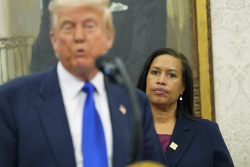China is applying the real lessons of the Manhattan Project to AI—talent and steady research funding—while America risks forgetting its own blueprint.
As both China and the United States commemorate the eightieth anniversary of the close of the Second World War, the echoes of its end reverberate on both sides of the Pacific. While the United States was behind the Manhattan Project, it is China that is applying the lessons learned from building the bomb, using them in the race for ever-more advanced artificial intelligence (AI) systems that will revolutionize warfare.
Misreading the Manhattan Project
Applying the logic behind the Manhattan Project to the development of AI is appealing—a mad, government-sponsored dash towards unleashing a novel science will set the stage for the future of combat. The current administration is enamored of the analogy; Energy Secretary Chris Wright has drawn explicit parallels between the 1945 initiative and AI, while administration allies have called for a series of initiatives for AI based on the bomb’s construction.
But it’s a comparison based on a misunderstanding. The Manhattan Project was not the culmination of three years of work, but the result of decades of cultural development. It demonstrates the success of America’s long-term approach to science as an endless frontier that can only be nurtured by government spending in basic science and a culture of scientific openness shared among America’s closest allies—especially Britain in the case of the nuclear bomb. It is those tenets that offer a roadmap for pursuing powerful AI.
America’s Scientific Magnetism
In the 1930s to 1940s, this freedom to think and share ideas stood in marked contrast to growing fascism in Europe. While Germany was home to a disproportionate number of the greatest minds in physics at the beginning of the twentieth century—including Albert Einstein, Max Planck, and Werner Heisenberg—it was the United States that attracted the world’s brightest scientific talents away from the Nazi regime.
The United States has continued to be a magnet for great minds. Soviet scientists defected to the United States throughout the decades of the Cold War, often for the freedom to pursue their work without Communist interference and dogma.
China’s Talent Offensive
In the years since the Soviet Union’s collapse, America has attracted the best and brightest from another communist country, China. Hundreds of thousands of Chinese students have studied at US institutions, and many of them have stayed, contributing scientifically to the home they have chosen.
As China—and its ambitions—have developed, it is a trend that Beijing has been keen to reverse. Not just by keeping their own students at home, but by poaching experts from around the world, by fair means and foul. In addition to illicit efforts to recruit American experts, Beijing is expanding its public sales pitch, introducing a new visa system allowing young tech and science talent to enter the country.
Money, of course, plays a huge role. It’s one of the ways a country shows its priorities and a snapshot of the greater culture. While America is cutting back on domestic research funding, Beijing is racing ahead and is now projected to spend more than Washington on research and development.
While intellectual freedom in the humanities may never be a Chinese priority, Beijing has redoubled its efforts to fund its expansive network of universities, increased basic research funding, and poured resources into its domestic AI industry, forming a tightly knit network of academics, engineers, and company founders to pioneer new projects. Increasingly, it appears, China is the place to be.
Ensuring the Talent for the AI Race
Meanwhile, America has forgotten its own lesson about the importance of capturing foreign talent. Instead, in an era of uncertainty about the future of government research grants, it’s American scientists who are expressing a desire to move abroad at near-record levels.
Just as moving ahead in nuclear physics required an influx of foreign talent, developing AI will also require a commitment to expanding and deepening the nation’s expertise by recruiting international students and researchers. Beijing understands the importance of collecting, nurturing, and utilizing intellectual talent as a long-term strategic resource.
President Donald Trump should prioritize the same, upholding his campaign promise to offer a green card to every college and university graduate with degrees in science, technology, mathematics, and engineering.
To ensure people come and stay in the United States, it is necessary to provide them with the tools they need to work effectively. AI dominance will not be free. Congress must fund the National Science Foundation, National Institutes of Health, and National Institute of Standards and Technology to fuel breakthroughs in AI development and deployment. Washington can ease this burden by collaborating with its closest allies and partners to fund joint research ventures, invest in data centers, and share national datasets for training frontier models.
These are the real lessons behind the Manhattan Project: it takes long-term commitment to freedom of thought and research to conquer scientific heights. To secure its future as a technological leader, Washington should look beyond short-term incentives to sprint ahead and focus on its capacity for inventiveness over the long term.
About the Authors: Jack Burnham and Annie Fixler
Jack Burnham is a research analyst in the China Program at the Foundation for Defense of Democracies (FDD). Follow Jack on X @JackBurnham802.
Annie Fixler is the Director of FDD’s Center on Cyber and Technology Innovation and a Senior Fellow. Follow Annie on X @afixler.
Image: rawf8/Shutterstock

















